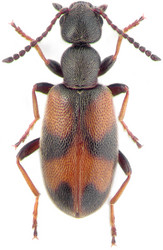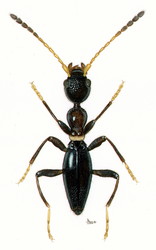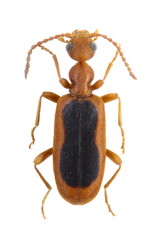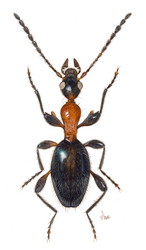Anthicinae
Dmitry Telnov


This tree diagram shows the relationships between several groups of organisms.
The root of the current tree connects the organisms featured in this tree to their containing group and the rest of the Tree of Life. The basal branching point in the tree represents the ancestor of the other groups in the tree. This ancestor diversified over time into several descendent subgroups, which are represented as internal nodes and terminal taxa to the right.

You can click on the root to travel down the Tree of Life all the way to the root of all Life, and you can click on the names of descendent subgroups to travel up the Tree of Life all the way to individual species.
For more information on ToL tree formatting, please see Interpreting the Tree or Classification. To learn more about phylogenetic trees, please visit our Phylogenetic Biology pages.
close boxIntroduction
The Anthicinae is the most species-rich subfamily of Anthicidae. 41 genera, 3 subgenera and about 2500 recent and fossil species are hitherto known from around the globe. The Anthicinae are divided into four tribes: Anthicini (32 genera and 3 subgenera), Endomiini (single genus), Formicomini (4 genera), and Microhorini (4 genera).
Many of the Anthicinae resemble ants in their behavior and in exernal morphology. Several groups were found to live in close association with ants (for example, Anthelephila, Pseudoleptaleus). Many genera are canthariphilous (for example, Aulacoderus, Notoxus).
Characteristics
Frontoclypeal suture present or replaced by a transverse impression or absent in a few groups. Mandibles bidentate apically. Neck is narrow, smooth, 1/4 or less of maximum head width.
Pronotum with anterior collar. Prebasal sulcus distinct in most groups. Mesosternum trinagular or transverse. Mesepisterna separated from ventrite by distinct suture. Metacoxae moderately to widely separated by intercoxal projection.
Elytra more or less distinctly punctate.
Legs with distinct tibial spurs. Tarsal claws simple.
Male genitalia usually with phallobase and tegmen distinct. Penis free. Phallobase can be enlarged and fused to tegmen in most of Microhorini. Sternite IX usually Y-shaped.
Classification
Note: all taxa below are listed alphabetically.
- Anthicini Latreille, 1819
- Acanthinus LaFerté-Sénectère, 1849 (= Dilandus Casey, 1895; = Liobaulius Casey, 1904; = Formicilla Casey, 1904, nec LeConte, 1851; = Formicomus Casey, 1904 (New World species, in part); = Leptaleus Casey, 1904, nec LaFerté-Sénectère, 1849 (New World species, in part); = Pseudoleptaleus Casey, 1904, nec Pic, 1903, New World species, in part) - North & South America, Australia
Alloeoceras Krekich-Strassoldo, 1914 - Oriental region
Amblyderus LaFerté-Sénectère, 1847 (= Inamblyderus Pic, 1911) - Palaearctic, Nearctic, Oriental and Afrotropical regions
Anthicodes Wollaston, 1877 - Saint Helena Island
Anthicomorphus Lewis, 1895 (= Walesius Pic, 1896) - Palaearctic, Oriental, Australian regions eastwards to Solomon Islands
Anthicus s. str. Paykull, 1798 (Birricolles Marseul, 1879; = Birricollis Sahlberg, 1903; = Birricomus Pic, 1894; = Brevicolles Marseul, 1879; Brevicollis Sahlberg, 1903; = Brevicomus Pic, 1894; Cartolus Mulsant, Rey, 1866; Curticolles Pic, 1892; = Curticomus Pic, 1894; = Eonius Thomson, 1864; = Laticomus Pic, 1894; = Nathicus Casey, 1895; = Nodolinus Mulsant, Rey, 1866; Platylorus Mulsant, Rey, 1866; = Pubicolles Marseul, 1879; = Pubicollis Sahlberg, 1903; = Pubicomus Pic 1894; = Recticolles Marseul, 1879) - cosmopolitan
Anthicus subgen. Odacanthicus Sakai, Ohbayashi, 1994 - Japan, Far East of Russia
Baulius Casey, 1895 - USA (monotypic genus)
Cordicollis Marseul, 1879 (= Bitumicolles Marseul, 1879; = Cordicollis Sahlberg, 1903; = Cordicomus Pic, 1894; = Laticolles Marseul, 1879; = Laticomus Pic, 1894) - Palaearctic, Oriental, Afrotropical regions
Cyclodinus Mulsant, Rey, 1866 (= Lagenicolles Marseul, 1879; = Lagenicollis Sahlberg, 1903; = Spinicornes Krekich-Strassoldo, 1919; = Spiniferes Pic, 1911; = Thicanus Casey, 1895) - cosmopolitan
Euproclus Fairmaire, 1900 (= Euproculus Alluaud, 1900; = Falsoeuproclus Pic, 1951) - Afrotropical, SW Palaearctic region (Egypt, Sahara)
Euvacusus Casey, 1904 - Southern USA (Colorado) (monotypic genus)
Falsoformicomus Pic, 1948 - Madagascar
Floydwernerius Telnov, 2007 - Australia, New Zealand
Formicilla LeConte, 1851 (= Formicus LeConte, 1861) - Nearctic, Neotropical regions
Hirticollis Marseul, 1879 (= Hirticollis Sahlberg, 1903; = Hirticomus Pic, 1894) - Palaearctic, Oriental, Afrotropical regions
Ischyropalpus LaFerté-Sénectère, 1849 (= Lappus Casey, 1895) - Nearctic, Neotropical regions
Leptaleus LaFerté-Sénectère, 1849 (= Ephippicolles Marseul, 1879) - Palaearctic, Oriental, Afrotropical regions
Leptanthicus Werner, 1958 - Southern USA (California) (monotypic genus)
Malporus Casey, 1895 - USA, Canada, Mexico
Micranthicus Champion, 1895 - Australia (monotypic genus)
Nitorus Telnov, 2007 - Palaearctic, Oriental, probably also Afrotropical regions
Omonadus Mulsant, Rey, 1866 (= = Hemantus Casey, 1895; = Trapezicolles Marseul, 1879; = Trapezicollis Sahlberg, 1903; = Trapezicomus Pic, 1894) - cosmopolitan genus
Phalantias Heberdey, 1936 - Southern India, Sri Lanka
Pseudocyclodinus Telnov, 2007 - Australia, New Zealand, New Caledonia, New Guinea, Solomon Islands, Fiji
Pseudoleptaleus Pic, 1900 - New Guinea, N Australia (Queensland)
Sapintus s. str. Casey, 1895 - cosmopolitan genus
Sapintus subgen. Barbigerosapintus Telnov, 1998 - Oriental region
Stricticollis Marseul, 1879 (= Stricticollis Sahlberg, 1903; = Stricticomus Pic, 1894; = Sulcicolles Marseul, 1879) - cosmopolitan genus
Tanarthrus s. str. LeConte, 1851 - Southern USA, Mexico
Tanarthrus subgen. Tanarthropsis Casey, 1985 - Southern USA, Mexico
Tenuicollis Marseul, 1879 (Tenuicollis Sahlberg, 1903; = Tenuicomus Pic, 1894) - Palaearctic, Oriental (only NW part), Afrotropical regions
Tomosomus Motschulsky, 1855 - Neotropical region (monotypic genus)
Vacusus Casey, 1895 - Nearctic, Neotropical regions
Yunnanomonticola Telnov, 2002 - Southern China - Endomiini Bonadona, 1958
- Endomia LaPorte de Castelnau, 1840 (Ochthenomus Schmidt, 1842) - Palaearctic, Oriental, Afrtropical, Australian regions
- Formicomini Bucciarelli, 1980
- Andrahomanus Pic, 1903 - Afrotropical region
Anthelephila Hope, 1833 (= Formicoma Motschulsky, 1845; = Formicomus LaFerté-Sénectère, 1849; = Formicosoma Motschulsky, 1845; = Myrmecosoma Mannerheim, 1846; = subgen. Orthauchen Krekich-Strassoldo, 1925) - Palaearctic, Oriental, Afrtropical, Australian regions
Chileanthicus Werner, 1966 - Chile, Australia
Stenidius LaFerté-Sénectère, 1849 (Stenicolles Marseul, 1879) - Palaearctic, Oriental, Afrotropical regions - Microhorini Bucciarelli, 1980
- Aulacoderus LaFerté-Sénectère, 1849 (Biscissicolles Marseul, 1879) - Palaearctic, Oriental, Afrotropical regions
Clavicollis Marseul, 1879 (= Clavicollis Sahlberg, 1903; = Clavicomus Pic, 1894; Pseudanthicus Desbrochers des Loges, 1868) - Palaearctic, Oriental, Afrotropical regions
Liparoderus LaFerté-Sénectère, 1849 (Rotundicolles Marseul, 1879) - Palaearctic region (SW Europe & Northern Africa)
Microhoria Chevrolat, 1877 (= Bifossicolles Marseul, 1879; = Bifossicollis Sahlberg, 1903; = Immicrohoria Pic, 1894; = Monstrosipedes Marseul, 1879; = Normalipedes Marseul, 1879; = Platyhoria Bonadona, 1952; = Submicrohoria Bonadona, 1952) - Palaearctic, Oriental, Afrotropical region
Title Illustrations

| Scientific Name | Anthicus (Anthicus) antherinus antherinus |
|---|---|
| Location | European Russia |
| Reference | Telnov D. 2010. Ant-Like Flower Beetles (Coleoptera: Anthicidae) of the UK, Ireland and Channel Isles. – British Journal of Entomology and Natural History 23: 99-117, 3 pls. |
| Creator | Kirill V. Makarov |
| Acknowledgements | I thank Dr. Kirill V. Makarov (Moscow Pedagogical State University) for this excellent photograph. |
| Specimen Condition | Dead Specimen |
| Identified By | D.Telnov |
| Sex | Female |
| Life Cycle Stage | imago |
| View | dorsal |
| Collection | Moscow Pedagogical State University |
| Copyright | © 2007 Kirill V. Makarov |
About This Page
Dmitry Telnov

The Entomological Society of Latvia
Correspondence regarding this page should be directed to Dmitry Telnov at
Page copyright © 2011 Dmitry Telnov
All Rights Reserved.
- First online 06 January 2011
- Content changed 06 January 2011
Citing this page:
Telnov, Dmitry. 2011. Anthicinae. Version 06 January 2011 (under construction). http://tolweb.org/Anthicinae/66152/2011.01.06 in The Tree of Life Web Project, http://tolweb.org/













 Go to quick links
Go to quick search
Go to navigation for this section of the ToL site
Go to detailed links for the ToL site
Go to quick links
Go to quick search
Go to navigation for this section of the ToL site
Go to detailed links for the ToL site